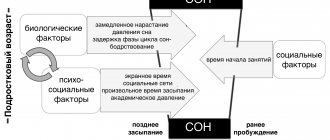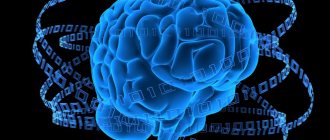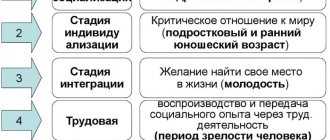Idiocy is the most severe degree of mental retardation. Patients suffer from this pathology from the moment of birth. Pathology can be detected already in a baby in the first weeks of life due to visual lag in psychomotor development.
The patients are completely helpless. They do not develop psychologically and emotionally. They are unable to recognize loved ones and relatives; they do not speak. Sick babies are born to absolutely healthy parents. The IQ of such sick patients will never exceed 20 throughout their lives.
Such children are not capable of learning. They don’t even learn basic self-care skills. They may exhibit obscene behavior and are unkempt. Children practically do not show positive emotions, but show a high tendency to aggression and self-aggression. They can tear their hair, pinch and bite themselves and others. Patients require lifelong supervision. In the most difficult cases, the ability to perceive the surrounding world is completely absent, not even the slightest motor activity.
Amaurotic idiocy
It is one of the most difficult variants of this most difficult diagnosis. In patients with amaurotic idiocy, the pathology progresses as they grow older. In a short time, the degradation of intelligence begins, which in a short time reaches the level of complete idiocy with a lack of reaction to any external stimuli. The patient's level of vision decreases, leading to complete blindness. Doctors identify a special structure of the fundus of the eye in those suffering from this pathology.
At the moment, the exact causes of the disease have not been identified. Observations of patients suggest the presence of a hereditary predisposition; pathology is often observed in related marriages. At birth, the baby suffers from hydrocephalus. He suffers from seizures and paralysis. Life expectancy does not exceed several months.
Prevention of oligophrenia
Since mental retardation is very often caused precisely by problems of intrauterine development, preventive measures include:
- registration in the housing complex before 12 weeks of pregnancy;
- regular visits to the pregnant gynecologist, timely testing, ultrasound diagnostics;
- quitting smoking and drinking alcohol;
- taking daily walks in the fresh air;
- quality rest (sleep at least 8 hours a day);
- rational and balanced nutrition;
- the use of gentle methods of obstetrics, refusal of obstetric forceps.
This article is posted for educational purposes only and does not constitute scientific material or professional medical advice.
Moronic idiocy
Debility is one of the degrees of mental retardation. This pathology can be either congenital or acquired. Among the reasons leading to debility, doctors note the following factors:
- hereditary predisposition, including generative pathology of the cells of the patient’s parents, in this case Down’s disease, true microcephaly and other pathologies of a similar type may develop;
- infection of the embryo or fetus during intrauterine development when the mother suffered during this period diseases such as rubella, syphilis, toxoplasmosis, and other infections caused by viruses;
- harmful factors that the child had to endure in the first three years of life, including head injuries, conflict between the Rh factor of the mother and the fetus, birth injuries and more.
Such patients can, with proper training, take care of themselves; they are educated in auxiliary schools. Some patients are partially gifted. With low overall thinking productivity, they, for example, can do mental arithmetic well. Patients may be apathetic or, conversely, have an increased level of excitability.
What causes profound mental retardation?
The predisposition to the manifestation of this disorder most often occurs in the womb or in childhood. Birth or postpartum trauma, as well as manifesting Down syndrome, are key causes of development.
Other causes of mental retardation:
— Transmission of infection by the mother during pregnancy; - The birth of a child weighing up to 1 kilogram (which is manifested by both physical weakness and mental retardation); — Poisoning of the mother’s body as a result of exaggerated dosage of antibiotics, chemical elements, antipsychotics.
Moronic imbecility idiocy
Patients suffering from oligophrenia may differ in level of development depending on the type. Mental retardation is divided into debility, imbecility and idiocy. Debility on this list is the least complex case of pathology. Patients are able to care for themselves. Many graduate from a specialized school and in the future can lead an almost full-fledged lifestyle, working in production, performing simple ore operations, for example, cleaning, loading and unloading. Due to impaired perception of the surrounding world, persons suffering from oligophrenia in the stage of debility require lifelong monitoring.
Treatment
All therapeutic measures for this disease are aimed at symptomatic and pathogenetic effects on the patient’s body. Curing idiocy or significantly improving the patient’s mental activity is impossible due to the specific congenital and hereditary nature of the pathology.
Pathogenetic treatment is aimed at replenishing enzyme and hormonal deficiencies. Enzymes and corticosteroid drugs are prescribed. If congenital forms of syphilis or toxoplasmosis are detected, specific anti-infective treatment is prescribed.
Symptomatic therapy consists of dehydration, restorative and sedative measures. Diuretics are prescribed for increased intracranial pressure (magnesia, furosemide, acetazolamide). Prescription of vitamin complexes is mandatory. In order to restore mental functions, drugs are prescribed that improve metabolism in brain tissue (piracetam, gamma-aminobutyric acid, cinnarizine).
To stimulate neuropsychic processes in the torpid clinical form of idiocy, preparations of ginseng, Chinese lemongrass, aloe, and mesocarb are prescribed. If the patient has an excitable form, antipsychotics are prescribed; if epileptic seizures occur, anticonvulsants are prescribed. Physical therapy (physical therapy) has a positive effect. As a rule, such patients spend most of their time in a hospital setting, as they require constant care and observation.
Idiocy imbecility
The average degree of oligophrenia is called imbecility. The pathology can be congenital or occur in the first months of life in case of head injuries or certain viral infections.
Imbeciles, unlike morons, are not able to fully take care of themselves, but can independently perform simple mechanical actions. For example, they are able to provide their own hygiene care. Patients suffering from oligophrenia in the imbecility stage may be recognized as trainable. They learn simple reading skills. As a rule, such patients are not able to master counting and perform simple mathematical operations. At the same time, such patients show a high degree of attachment to their relatives, they understand related feelings, and can find friends among similar patients. But they are distinguished by a complete lack of initiative. They get lost at the slightest change in the environment. They require constant care and are not capable of any independent actions.
Idiocy is the most complex degree of mental retardation. With this variant of the pathology, thinking and speech are almost completely absent. On the emotional level, patients are only able to demonstrate the presence of pleasure or displeasure at the most primitive level. Such patients are unable to distinguish relatives from strangers. They can pronounce only separate, unrelated and unconscious sounds.
REASONS FOR APPEARANCE
As mentioned above, brain damage and structural defects are to blame for underdevelopment of the brain. There are the following main groups that determine the presence of a control system:
- hereditary diseases (chromosomal and genetic);
- intrauterine infections - toxoplasmos, rubella and others that negatively affect the fetus;
- maternal consumption of toxic substances, alcoholic beverages, strong drugs, radiation, smoking;
- fetal prematurity;
- problems during childbirth and in the first months of a child’s life - oxygen starvation, mechanical head injuries, infectious diseases;
- lack of normal upbringing, training and socialization, the impossibility of full-fledged brain function as a result of this;
- unknown etiology.
Familial amaurotic idiocy
Complex and severe form of mental retardation. The pathology is based on a genetic disorder of lipid metabolism. The first manifestations of the diagnosis are most often detected between the ages of three and six months. The changes manifest themselves in degenerative processes in the retina of the eye, leading to complete blindness, progressive muscle weakness and complete mental retardation.
In medical practice, there are four types of pathology:
- Being an early form of Tay-Sachs disease, children who suffer from this diagnosis die at the age of a maximum of three years from increasing cachexia.
- The late form, which is called Bolshovsky-Yasky disease, symptoms appear in children aged 2-4 years. Children die at the age of 5-7 years.
- The juvenile variant, Spielmeyer-Vogt-Batten disease, begins to appear between the ages of 5 and 15 years. Patients suffer from paralysis, convulsive seizures, and their dementia progresses. The maximum life expectancy reaches 20 years in most cases.
- In adulthood, Kufs disease may begin to develop. Symptoms are similar to all types of this pathology. In this case, vision decreases gradually, paralysis and epileptic symptoms develop, and pronounced pigmentation of the fundus is present.
Regardless of the form of the pathology, there is currently no treatment. Only supportive therapy is used to alleviate the patient's suffering.
General information about the disease
The origin of the term idiocy comes from the Greek “idioteia” - inability to learn, “idios” - living for oneself. This is such a deep form of mental underdevelopment that the IQ is less than 20 (sometimes 20-35). Of all patients with oligophrenia, idiocy accounts for 3-5%.
Occurs in the population in 1 case per 10,000 people. This is a rather rare but progressive pathology that manifests itself from the first months of a child’s life. Disorders of mental functions have a highly pronounced progressive course and are accompanied by severe pathology in the activity of internal organs.
Severe idiocy
In medical practice, there are several degrees of this form of mental retardation. Patients who have mild to moderate degrees are able to learn the simplest actions. They are sometimes able to recognize people who constantly communicate with them, distinguish between hot and cold. With constant practice, they are able to master several words, although they usually do not realize their meaning and cannot apply them in life.
Severe idiocy is the most complex variant of the highest degree of oligophrenia idiocy. Patients suffering from this diagnosis are able to lead only a vegetative existence. They do not react to the surrounding reality. Able to only pronounce individual unconscious sounds. Such patients require constant care. The development level corresponds to newborn children.
The downside of the diagnosis is that only doctors or people who spend a lot of time with the patient understand the difference in degrees. In fact, all three degrees are actually no different from each other.
DIAGNOSTICS
Mental development disorders are difficult to detect at an early stage. However, such diagnosis is extremely necessary for early correction and compensation of the detected defect.
The diagnosis of “mental retardation” is made on the basis of special methods that allow assessing the intellectual level of an individual. Sometimes specialists use neuropsychological diagnostics, which allows us to determine the level of development of higher mental functions, as well as assess the child’s potential.
A correctly made diagnosis makes it possible to timely develop corrective methods to eliminate the pathology and treat it. In this case, the doctor must make sure that the little patient does not have signs of progression of underdevelopment or signs of more serious mental illnesses (schizophrenia, schizoaffective disorder, etc.).
It is also important to determine that the patient’s condition is not pedagogical neglect. This often happens to children who have lost their parents and were sent to an orphanage. There they can be subjected to harsh treatment, bullying, violence, etc. But if the child changes the situation for a better one - he is adopted, he lives and is raised in a normal family, then his condition returns to normal.
Forms of idiocy
At the moment, doctors distinguish two forms of the most severe degree of mental retardation and idiocy:
- Torpid, patients suffering from it seem to be completely absent in space and time. Left to their own devices, they show no desire for even minimal movement. Without care, they die of hunger and thirst, as they are unable to understand the need to perform any actions.
- Excitable, in which case patients are in constant motion, constantly swinging like a pendulum, they can rhythmically beat their heads against the wall, floor, headboard, without feeling or understanding pain.
Regardless of the form, patients require constant care. They are unable to perform independent actions. Given the inability to recognize loved ones, doctors recommend sending such patients to specialized medical institutions.
The birth of a mentally retarded child with mental retardation in the stage of idiocy becomes a real curse for his family. Often relatives try to leave the patient with idiocy in the family, taking on onerous tasks in the field of care. In reality, doctors point out that such sacrifices are only advisable if it is possible to invite a professional nurse with a medical education to care for the patient. People suffering from this pathology often experience problems with the appearance of bedsores, they require monitoring due to the possibility of infection affecting the body, and require specialized hygiene procedures.
Symptoms of oligophrenia
Symptoms of oligophrenia in young children are:
- deviations in the structure of internal organs;
- disturbances in the structure of the body, face, head;
- pronounced signs of phenylketonuria;
- too pale skin;
- convulsions;
- sour odor of skin and urine;
- muscle weakness;
- very light blue eyes.
Also signs of oligophrenia in children are: inability to hold their head up, stand up, or sit.
Common symptoms of the disease, characteristic of both adults and children, include:
- mental retardation;
- retardation in physical development;
- speech disorders;
- problems associated with abstract thinking (patients cannot say what “apple”, “pear”, “banana” are called in one word, cannot explain what “love”, “friendship”, “anger”, etc. are);
- problems in recognizing people and things (with severe degrees, mental retardation cannot even recognize their relatives);
- difficulties in performing household work, in mastering various types of activities (writing, reading, counting), in self-care (getting dressed, eating, washing, combing your hair);
- tendency to obey other people, increased suggestibility;
- emotional disturbances in the form of outbursts of anger, aggression, irritability.
The extent to which certain symptoms are expressed in a patient depends on his state of health and individual characteristics.
If you experience similar symptoms,
consult your doctor . It is easier to prevent a disease than to deal with the consequences.








